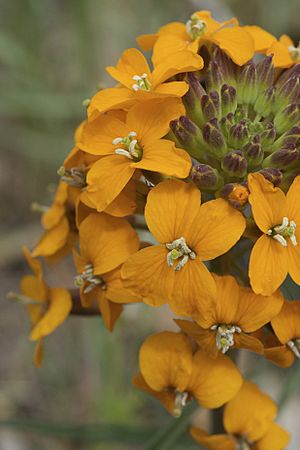Erysimum capitatum facts for kids
Quick facts for kids Erysimum capitatum |
|
|---|---|
 |
|
| Conservation status | |
| Scientific classification | |
| Genus: |
Erysimum
|
| Species: |
capitatum
|
Erysimum capitatum is a type of wallflower plant. It's often called the sanddune wallflower, western wallflower, or prairie rocket. You can find this plant growing naturally across North America. It grows from the Great Lakes area all the way to the West Coast of the United States. Some kinds of this wallflower only grow in very small areas, especially in California.
Contents
What the Wallflower Looks Like
Erysimum capitatum is a plant that looks a bit like a mustard plant. It has thin, straight stems that grow up from a group of leaves at the bottom, called a rosette. At the top of the stems, you'll see thick bunches of flowers. These flowers can be many different colors.
Most of the time, the flowers are bright golden, yellow, or orange. But some plants might have red, white, or even purple flowers. Each flower has four flat petals. The seed pods, which hold the seeds, grow almost straight up next to the stem.
Different Kinds of Wallflowers
There are several different types, or subspecies, of this wallflower plant. Some of these types are even listed as endangered species. This means they are at risk of disappearing forever. For example, Erysimum capitatum var. angustatum, also known as the Contra Costa wallflower, is an endangered plant in California.
Here are some of the different kinds:
- E. c. var. angustatum—This is the Contra Costa wallflower. It only grows in California and is an endangered species.
- E. c. var. bealianum—Called the Sanddune wallflower, it grows in the Mojave Desert in California.
- E. c. var. capitatum—This is the Western wallflower. Its flowers bloom from May to July. You can find it widely across Colorado and Utah.
- E. c. var. lompocense—Known as the San Luis Obispo wallflower, it only grows in California.
- E. c. var. perenne (also called Erysimum perenne)—This is another Sanddune wallflower type. It also only grows in California.
- E. c. var. purshii—This type is called Pursh's wallflower. It grows in the Western United States.

How Wallflowers Get Pollinated
We don't have a lot of information about how this wallflower species works with pollinators. Pollinators are animals, like bees or butterflies, that help plants make seeds.
One scientist, Andrew Moldenke, studied a group of Erysimum capitatum var. perenne plants. These plants were growing high up in the mountains, between 2,900–3,500 metres (9,500–11,500 ft) high. He saw 13 different kinds of animals visiting the flowers. However, more than 80% of these visits were made by two types of ants: Formica lasioides and one from the Formica fusca group.
Growing Wallflowers in Gardens
Erysimum capitatum is grown by people as an ornamental plant. This means it's planted because it looks pretty. It's a lovely perennial plant, which means it lives for more than two years.
It can look different depending on where it grows. People often use it in butterfly gardening. This is when you plant flowers that attract butterflies to your garden.
Traditional Uses of the Plant
In Zuni ethnobotany, which is how the Zuni people traditionally use plants, this wallflower has some special uses. They would make a liquid from the whole plant. This liquid was then rubbed on the outside of the body to help with muscle aches. The Zuni people also ate the flower and the fruit. They used it as an emetic, which means it would make them throw up, to help with stomachaches.


